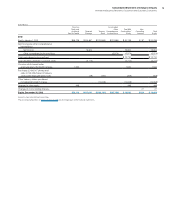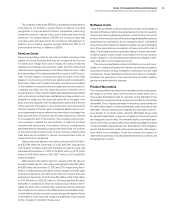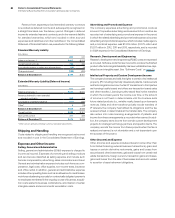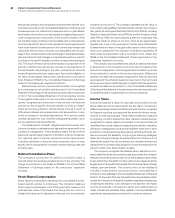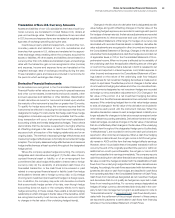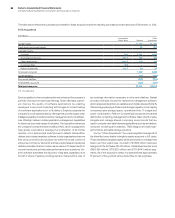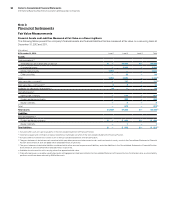IBM 2012 Annual Report Download - page 86
Download and view the complete annual report
Please find page 86 of the 2012 IBM annual report below. You can navigate through the pages in the report by either clicking on the pages listed below, or by using the keyword search tool below to find specific information within the annual report.Notes to Consolidated Financial Statements
International Business Machines Corporation and Subsidiary Companies
85
In determining whether an other-than-temporary decline in market
value has occurred, the company considers the duration that, and
extent to which, the fair value of the investment is below its cost, the
financial condition and near-term prospects of the issuer or underly-
ing collateral of a security; and the company’s intent and ability to
retain the security in order to allow for an anticipated recovery in fair
value. Other-than-temporary declines in fair value from amortized
cost for available-for-sale equity and debt securities that the company
intends to sell or would more likely than not be required to sell before
the expected recovery of the amortized cost basis are charged to
other (income) and expense in the period in which the loss occurs.
For debt securities that the company has no intent to sell and believes
that it more likely than not will not be required to sell prior to recovery,
only the credit loss component of the impairment is recognized in
other (income) and expense, while the remaining loss is recognized
in OCI. The credit loss component recognized in other (income) and
expense is identified as the amount of the principal cash flows not
expected to be received over the remaining term of the debt security
as projected using the company’s cash flow projections.
Inventories
Raw materials, work in process and finished goods are stated at the
lower of average cost or market. Cash flows related to the sale of
inventories are reflected in net cash provided by operating activities
in the Consolidated Statement of Cash Flows.
Allowance for Credit Losses
Receivables are recorded concurrent with billing and shipment of a
product and/or delivery of a service to customers. A reasonable
estimate of probable net losses on the value of customer receivables
is recognized by establishing an allowance for credit losses.
Notes and Accounts Receivable—Trade
An allowance for uncollectible trade receivables is estimated based
on a combination of write-off history, aging analysis and any specific,
known troubled accounts.
Financing Receivables
Financing receivables include sales-type leases, direct financing
leases and loans. Leases are accounted for in accordance with
lease accounting standards. Loan receivables are financial assets
recorded at amortized cost which approximates fair value. The com-
pany determines its allowances for credit losses on financing
receivables based on two portfolio segments: lease receivables and
loan receivables. The company further segments the portfolio into
two classes: major markets and growth markets.
When calculating the allowances, the company considers its abil-
ity to mitigate a potential loss by repossessing leased equipment and
by considering the current fair market value of any other collateral.
The value of the equipment is the net realizable value. The allowance
for credit losses for capital leases, installment sales and customer
loans includes an assessment of the entire balance of the capital
lease or loan, including amounts not yet due. The methodologies that
the company uses to calculate its receivables reserves, which are
applied consistently to its different portfolios, are as follows:
Individually Evaluated—
The company reviews all financing receiv-
ables considered at risk on a quarterly basis. The review primarily
consists of an analysis based upon current information available
about the client, such as financial statements, news reports, pub-
lished credit ratings, current market-implied credit analysis, as well
as the current economic environment, collateral net of repossession
cost and prior collection history. For loans that are collateral depen-
dent, impairment is measured using the fair value of the collateral
when foreclosure is probable. Using this information, the company
determines the expected cash flow for the receivable and calculates
an estimate of the potential loss and the probability of loss. For
those accounts in which the loss is probable, the company records
a specific reserve.
Collectively Evaluated—The company records an unallocated
reserve that is calculated by applying a reserve rate to its different
portfolios, excluding accounts that have been specifically reserved.
This reserve rate is based upon credit rating, probability of default,
term, characteristics (lease/loan) and loss history. Factors that could
result in actual receivable losses that are materially different from
the estimated reserve include sharp changes in the economy, or a
significant change in the economic health of a particular client that
represents a concentration in the company’s receivables portfolio.
Other Credit-Related Policies
Non-Accrual—Certain receivables for which the company has
recorded a specific reserve may also be placed on non-accrual
status. Non-accrual assets are those receivables (impaired loans or
nonperforming leases) with specific reserves and other accounts
for which it is likely that the company will be unable to collect all
amounts due according to original terms of the lease or loan agree-
ment. Income recognition is discontinued on these receivables. Cash
collections are first applied as a reduction to principal outstanding.
Any cash received in excess of principal payments outstanding is
recognized as interest income. Receivables may be removed from
non-accrual status, if appropriate, based upon changes in client
circumstances.
Write Off—Receivable losses are charged against the allowance
when management believes the uncollectibility of the receivable
is confirmed. Subsequent recoveries, if any, are credited to the
allowance.
Past Due—
The company views receivables as past due when
payment has not been received after 90 days, measured from the
original billing date.
Impaired Loans—As stated above, the company evaluates all financ-
ing receivables considered at-risk, including loans, for impairment
on a quarterly basis. The company considers any loan with an indi-
vidually evaluated reserve as an impaired loan. Depending on the
level of impairment, loans will also be placed on non-accrual status
as appropriate. Client loans are primarily for software and services
and are unsecured. These loans are subjected to credit analysis to
evaluate the associated risk and, when deemed necessary, actions
are taken to mitigate risks in the loan agreements which include
covenants to protect against credit deterioration during the life of
the obligation.


